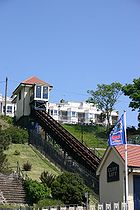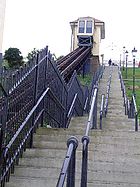
Southend Cliff Railway
Encyclopedia


Funicular
A funicular, also known as an inclined plane or cliff railway, is a cable railway in which a cable attached to a pair of tram-like vehicles on rails moves them up and down a steep slope; the ascending and descending vehicles counterbalance each other.-Operation:The basic principle of funicular...
in the English
England
England is a country that is part of the United Kingdom. It shares land borders with Scotland to the north and Wales to the west; the Irish Sea is to the north west, the Celtic Sea to the south west, with the North Sea to the east and the English Channel to the south separating it from continental...
seaside resort
Seaside resort
A seaside resort is a resort, or resort town, located on the coast. Where a beach is the primary focus for tourists, it may be called a beach resort.- Overview :...
of Southend-on-Sea
Southend-on-Sea
Southend-on-Sea is a unitary authority area, town, and seaside resort in Essex, England. The district has Borough status, and comprises the towns of Chalkwell, Eastwood, Leigh-on-Sea, North Shoebury, Prittlewell, Shoeburyness, Southchurch, Thorpe Bay, and Westcliff-on-Sea. The district is situated...
, constructed in 1912.
The line is owned and operated by Southend-on-Sea Borough Council, and has the following technical parameters:
- Length: 130 feet (39.6 m)
- Height difference: 57 feet (17.4 m)
- Gradient: 43,4%
- Cars: 1
- Capacity: 18 passengers per car
- Configuration: Single track, with separate counterweight track
- Main track gauge: 4 in 6 in (1,371.6 mm)
- Counterweight track gauge: 1 in 9 in (533.4 mm)
- Traction: Electricity
The line operates daily in summer between 1000 and 1745. A fare of 50 pence per trip is charged.
The line has an unusual configuration, as it runs on a single-track elevated structure. The counterweight track runs within this structure, immediately below the main track that carries the passenger car.
The line runs on the site of a pioneering moving walkway, a forerunner of today's escalator
Escalator
An escalator is a moving staircase – a conveyor transport device for carrying people between floors of a building. The device consists of a motor-driven chain of individual, linked steps that move up or down on tracks, allowing the step treads to remain horizontal.Escalators are used around the...
. This was constructed in 1901 by the American engineer Jesse W. Reno
Jesse W. Reno
Jesse Wilford Reno invented the first working escalator in 1891 used at the Old Iron Pier, Coney Island, New York City...
, but soon proved noisy and unreliable due its exposed location. The current line was opened in 1912, and has been modernised three times since, in 1930, 1959 and 1990. Each modernisation has resulted in the replacement of the car.
In 2003 the line was closed due to technical problems, and refurbishment was undertaken on the stations. However during the time that it was closed, the regulations governing its operation changed, requiring modifications before it could be reopened. The line finally re-opened on 25 May 2010, after a restoration costing a total of £3 million, £650,000 on the car alone.

